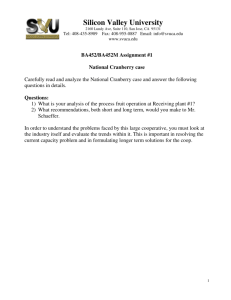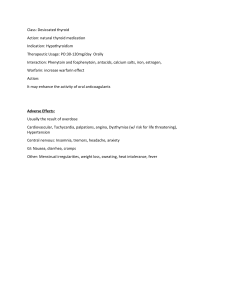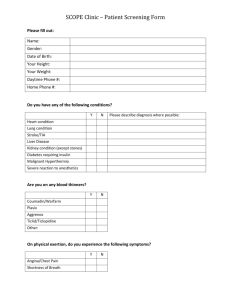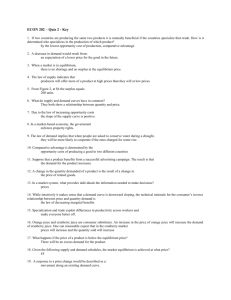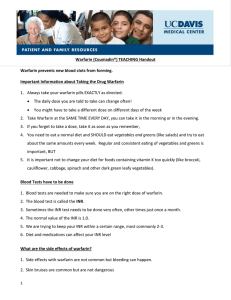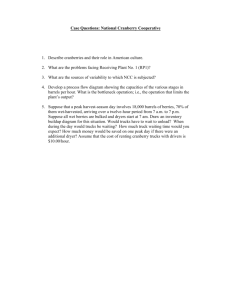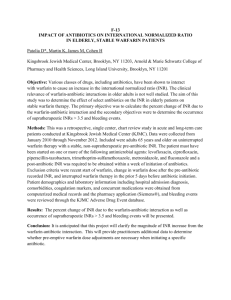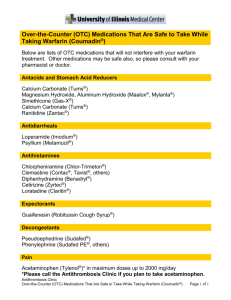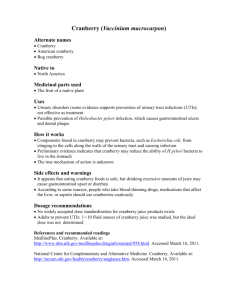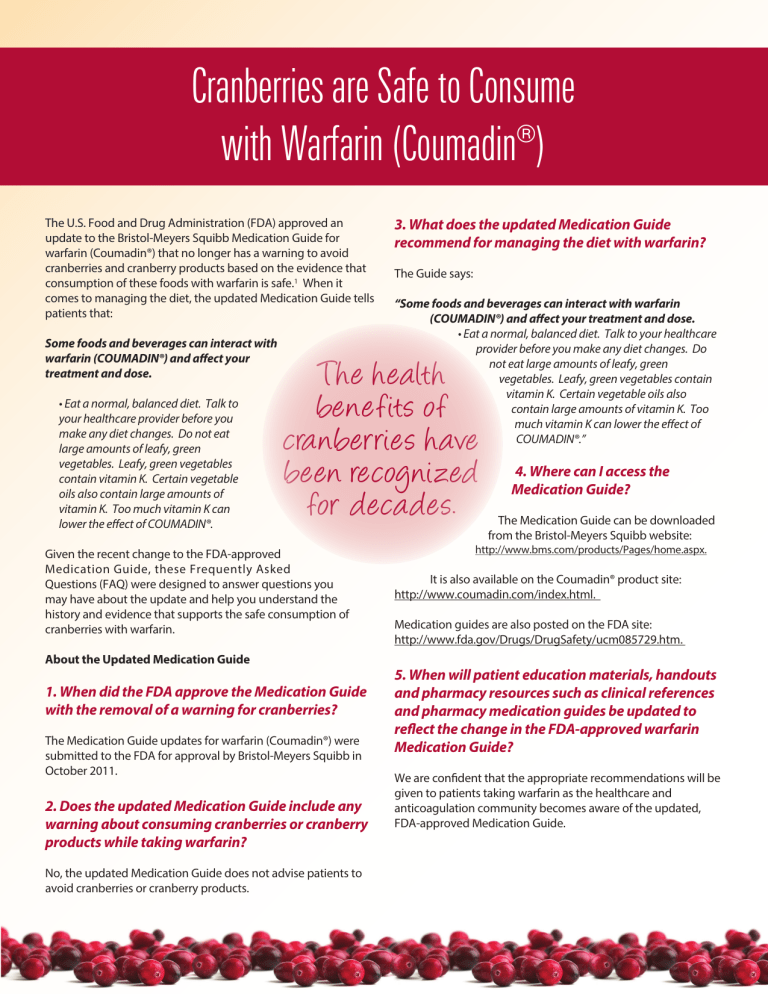
Cranberries are Safe to Consume with Warfarin (Coumadin®) The U.S. Food and Drug Administration (FDA) approved an update to the Bristol-Meyers Squibb Medication Guide for warfarin (Coumadin®) that no longer has a warning to avoid cranberries and cranberry products based on the evidence that consumption of these foods with warfarin is safe.1 When it comes to managing the diet, the updated Medication Guide tells patients that: Some foods and beverages can interact with warfarin (COUMADIN®) and affect your treatment and dose. • Eat a normal, balanced diet. Talk to your healthcare provider before you make any diet changes. Do not eat large amounts of leafy, green vegetables. Leafy, green vegetables contain vitamin K. Certain vegetable oils also contain large amounts of vitamin K. Too much vitamin K can lower the effect of COUMADIN®. 3. What does the updated Medication Guide recommend for managing the diet with warfarin? The Guide says: “Some foods and beverages can interact with warfarin (COUMADIN®) and affect your treatment and dose. • Eat a normal, balanced diet. Talk to your healthcare provider before you make any diet changes. Do not eat large amounts of leafy, green vegetables. Leafy, green vegetables contain vitamin K. Certain vegetable oils also contain large amounts of vitamin K. Too much vitamin K can lower the effect of COUMADIN®.” The health benefits of cranberries have been recognized for decades. Given the recent change to the FDA-approved Medication Guide, these Frequently Asked Questions (FAQ) were designed to answer questions you may have about the update and help you understand the history and evidence that supports the safe consumption of cranberries with warfarin. About the Updated Medication Guide 1. When did the FDA approve the Medication Guide with the removal of a warning for cranberries? The Medication Guide updates for warfarin (Coumadin®) were submitted to the FDA for approval by Bristol-Meyers Squibb in October 2011. 2. Does the updated Medication Guide include any warning about consuming cranberries or cranberry products while taking warfarin? No, the updated Medication Guide does not advise patients to avoid cranberries or cranberry products. 4. Where can I access the Medication Guide? The Medication Guide can be downloaded from the Bristol-Meyers Squibb website: http://www.bms.com/products/Pages/home.aspx. It is also available on the Coumadin® product site: http://www.coumadin.com/index.html. Medication guides are also posted on the FDA site: http://www.fda.gov/Drugs/DrugSafety/ucm085729.htm. 5. When will patient education materials, handouts and pharmacy resources such as clinical references and pharmacy medication guides be updated to reflect the change in the FDA-approved warfarin Medication Guide? We are confident that the appropriate recommendations will be given to patients taking warfarin as the healthcare and anticoagulation community becomes aware of the updated, FDA-approved Medication Guide. Cranberries are Safe to Consume with Warfarin (Coumadin®) 6. What data supports the removal of the warning against cranberry consumption with warfarin therapy? Since the previous Medication Guide update in 2009, clinical studies have been conducted to investigate whether an interaction truly exists.2 A study by Ansell et al, published in The Journal of Clinical Pharmacology found that there was no clinically relevant pharmacodynamic or pharmacokinetic interaction between warfarin and cranberry juice in patients consuming 8 oz. of cranberry juice a day.3 In a separate study, Mellen also found no interaction when patients consumed double the amount as tested in the Ansell study (two 8 oz. glasses of cranberry juice per day).4 In late 2010, Zikria et al, published a review of evidence in The American Journal of Medicine titled, “Cranberry Juice and Warfarin: When Bad Publicity Trumps Science”.5 The authors concluded that based on a systematic review of case reports as well as clinical trials, the initial precautionary warnings by administrating bodies were limited to anecdotal case reports and represented misleading conclusions. History of the Issue 7. Where did the question about cranberry consumption and warfarin originate? pg 2 on the evidence that consumption of these foods with warfarin is safe.1 The FDA approved the update shortly after submission. 8. What studies have been conducted to address the concerns about this potential drug-food interaction? At present, controlled, clinical pharmacokinetic, and pharmacodynamic studies have been published in scientific literature and did not show a clinically relevant interaction between cranberry juice and either warfarin metabolism or INR in subjects on warfarin.3-8 A randomized, double-blind trial by Ansell et al was published in the Journal of Clinical Pharmacology, which showed no clinically relevant interaction between cranberry juice and warfarin and suggested that “other factors were likely responsible for the findings in the anecdotal case reports.”3 In a separate but similar study, Mellen also found no interaction when patients consumed double the amount as tested in the Ansell study (two 8 oz. glasses of cranberry juice per day).4 In 2006, The Journal of the American Dietetic Association (JADA) published an article titled “Cranberry Does Not Affect Prothrombin Time in Male Subjects on Warfarin” and found no significant interaction between the daily consumption of 250 mL of cranberry juice and warfarin.6 In March 2007, Long Island University researchers reported in the American Journal of Health Systems Pharmacy that there did “not seem to be a clinically relevant interaction between cranberry juice and warfarin,” but advised cautioning patients about a potential interaction.8 The issue originated from 12 anecdotal case reports to the UK Committee for Safety in Medicine (CSM) between 2003-2004, prompting the CSM to release warnings about warfarin and cranberry consumption. Among these 12 case reports, eight people had an increase in INR (international normalization ratio) - a measure of blood clotting - three had an unstable INR and one had a decreased INR.5 Since these were medically complicated cases, many other factors could have impacted INR besides cranberry juice. However, one clinical trial, authored by Abdul et al, showed a modest increase in INR in 12 healthy volunteers that were not already taking warfarin. In this study, a single large dose of warfarin (25 mg) and cranberry extract capsules, containing 3000 mg of cranberry juice concentrate, was used in a non-blinded, open labeled study.9 Unlike previous studies, the large dose of cranberry may have contributed to the modest increase in INR. In 2006, based solely on the UK case reports, the FDA approved safety labeling revisions for warfarin to warn about the risk of major or fatal bleeding with their use. These revisions included a cranberry consumption warning which was included in packaging for warfarin. The package insert for Coumadin®, which is manufactured by Bristol-Myers Squibb stated: “Avoid drinking cranberry juice or eating cranberry products.”2 In late 2010, Zikria et al, published a review of evidence in The American Journal of Medicine titled, “Cranberry Juice and Warfarin: When Bad Publicity Trumps Science”.5 The authors concluded that based on a systematic review of case reports as well as clinical trials, the initial precautionary warnings by administrating bodies were limited to anecdotal case reports and represented misleading conclusions. In October 2011, Bristol-Meyers Squibb submitted an updated Medication Guide to the FDA for approval with the omission of the warning to avoid cranberries and cranberry products based 9. What was the design and results of the Ansell et al study? Thirty patients already on warfarin treatment and with stable INR levels participated in this study. Amongst the thirty patients, 14 were randomized to receive cranberry juice and 16 to receive the placebo. There was a 2-week lead in phase, 2-week intervention phase and 1-week follow-up phase (after exposure Cranberries are Safe to Consume with Warfarin (Coumadin®) to cranberry or placebo). During the intervention phase, patients consumed one 8 oz. glass of cranberry juice or placebo at the same time each day with INR levels being measured at this time. Patients were also advised to maintain a consistent diet throughout the study.3 During the intervention phase, eight of the thirty patients developed a minimally elevated INR exceeding 3.3. In general, the therapeutic range for INR with patients on warfarin treatment is 2.0-3.0 and a stable INR range is defined as an INR between 1.7-3.3. Four of these patients were in the placebo group and four in the cranberry juice group and the reasoning for this elevation remained unclear, but is likely due at least in part to the well-known variability of warfarin activity. One of the patients in the cranberry juice group had an INR of 1.69. During the final day of the intervention phase, the mean INR was significantly higher in the cranberry juice group compared to the placebo group, but mean INR levels were about identical during the next measurement, which was 24-hours later (the first follow-up day).3 The measurement of plasma warfarin levels for the placebo and cranberry juice group were the same throughout. This suggests that cranberry juice does not affect warfarin metabolism, which is consistent with the results of three other controlled, clinical, pharmacokinetic studies. The Journal of Clinical Pharmacology article finds that there is no clinically relevant pharmacodynamic or pharmacokinetic interaction between warfarin and cranberry juice.3 10. What are the benefits of maintaining the availability of cranberry products in the hospital setting? According to an article published in the Journal for Infection Control and Hospital Epidemiology in 2008, hospital-acquired pg 3 UTIs are the most common hospital acquired infections.10 In addition, UTIs are frequently encountered in nursing home facilities. Clinical evidence supports the claim that cranberry juice can help in the prevention of UTIs. Cranberries contain two compounds that inhibit certain harmful bacteria from adhering to the lining of the urinary tract, which is then flushed out of the body. Compounds in cranberries have been shown to prevent the adhesion of certain bacteria in other areas of the body that can cause stomach ulcers and periodontal gum disease. Emerging research also suggests that the high level of flavonoids found in cranberries may support cardiovascular health and help to prevent conditions that can lead to atherosclerosis such as elevated LDL levels.11 11. Where can I find more information about the benefits of cranberries? For more information on current and emerging cranberry research, visit www.Cranberryinstitute.org. 12. Where can I find general information about warfarin therapy, including diet recommendations, safety concerns and news updates? If you have questions about warfarin, visit: www.PTINR.com. The PTINR.com® website, developed by Alere™ Anticoagulation Solutions, is dedicated to informing people on warfarin how to live healthier, safer lives. The FDA also provides information about warfarin (Coumadin®): http://www.accessdata.fda.gov/scripts/cder/drugsatfda/ index.cfm?fuseaction=Search.DrugDetails. REFERENCES 1. Bristol-Myers Squibb Company.(2011).Medication Guide for Coumadin Tablets and Coumadin for Injection [Package Insert]. Princeton, NJ: Bristol-Myers Squibb Company. 6. Li, Z. , Seeram, N. P. , Carpenter, C.L., & Thames, G. (2006). Cranberry does not affect prothrombin time in male subjects on warfarin. J Am Diet Assoc., 106, 2057-2061. 2. Bristol-Myers Squibb Company.(2009).Medication Guide for Coumadin Tablets and Coumadin for Injection [Package Insert]. Princeton, NJ: Bristol-Myers Squibb Company. 7. Lilija, JJ, et al. (2007) Effects of daily ingestion of cranberry juice on the pharmacokinetics of warfarin, tizanidine, and midazolam-probes of CYP2C9, CYP1A2, and CYP3A4. Clin Pharmacol Ther., Epub ahead of print. 3. Ansell, J. , McDonough, M., Yanli, Z., Harmatz, J., & Greenblatt, D. (2009). The absence of an interaction between warfarin and cranberry juice: A randomized, double blind trial. J Clin Pharmacol., 49, 824-830. 8. Pham, D.Q., Pham, A.Q. (2007). Interaction potential between cranberry juice and warfarin. Amer J Health-System Pharm., 64(5):490-494. 4. Mellen, Chadwick K. (2010). Effect of high-dose cranberry juice on the pharmacodynamics of warfarin in patients. BJCP., DOI:10.1111/j.1365-2125.2010.03674 5. Zikria, J., Goldman, R., Ansell, J. (2010). Cranberry Juice and Warfarin: When Bad Publicity Trumps Science. Am J Med., 123, 384-392. 9. Abdul, MI., et al. (2008). Pharmacodynamic interaction of warfarin with cranberry but not with garlic in healthy subjects. Br J Pharmacol.,154,1691-1700. 10. Lo, E et al (2008). Strategies to prevent catheter associated urinary tract infections in hospitals. Infect Control Hosp Epidemiol., 29, S41-S50. 11. Reed, J. (2002). Cranberry flavanoids, atherosclerosis, and cardiovascular health. Crit Rev Food Sci Nutr., 42 (Supp), 301-316.
